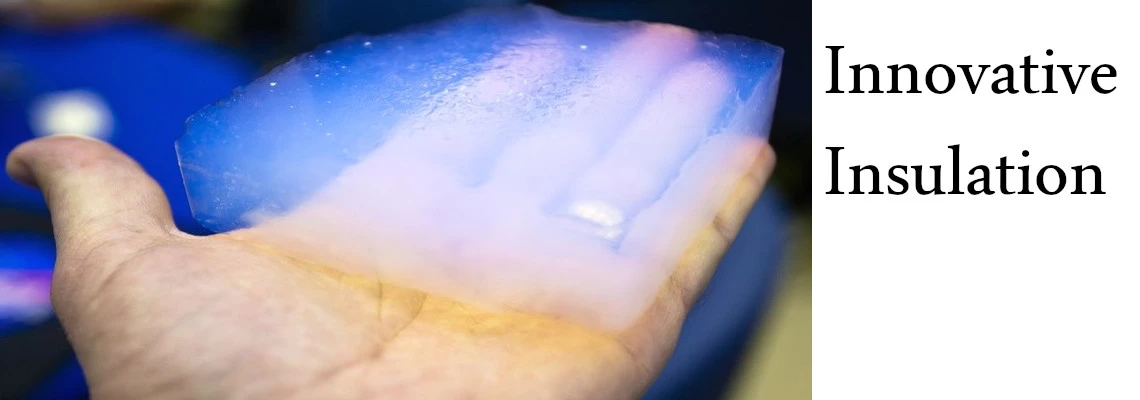
⌂ THE FUTURE OF HOME INSULATION. CUTTING-EDGE INSULATION*
Wave goodbye to bulky insulation and say hello to a fresh era of clever, space-saving thermal insulation. These revolutionary materials not only keep you cosy and save you money but also open up your living space for more comfort. And that's not all – they're changing the construction game, allowing builders to do more with less.
Imagine a world where energy efficiency and affordability go hand in hand, where innovative insulating materials play a pivotal role in maximising thermal comfort without compromising precious room space.
Step into the world of advanced insulation solutions that are on the horizon for homes just like yours. Join us as we explore the exciting innovations that are reshaping how we experience comfort and sustainability at home.
WHAT IS INNOVATIVE INSULATION?
Innovative thermal insulation has a very low lambda value. Very low lambda means thermal conductivity below 0.0016 W/mK. This, in turn, means that much thinner products can be used, while still gaining in usable space within the room. Compared to other, traditional insulation materials, this saves a lot of money, which represents a real gain in living space.
Innovative insulation also translates to saved time. Products that are easy to use speed up the construction or renovation process. A shortened timeline means saved money on labour costs.
Innovative insulation is also a novelty in its own right. Each new smart product in the market alters its trends. Older, bulky products are starting to phase out, making way for slim, easy-to-install alternatives.
Innovative insulation is a game changer not only in traditional structures but also in modular homes and even ships. Owners of campers, boats, and caravans understand well how crucial material thickness is in these scenarios. Here are a few insulation technologies that may be coming soon to a home near you.
INSULATION INNOVATIONS: WHAT'S NEW IN THE INDUSTRY
To achieve both top-notch energy efficiency and affordable housing, we need to make smart use of our valuable resources. This is where innovative insulating materials step up. Here are 3✔ innovative products currently available in the UK market:
① AEROGEL INSULATION TECHNOLOGY
Aerogel is the lightest and least dense solid insulation product on the planet. It is crafted from a jelly-like substance, combining aspects of both liquids and solids. Internally, this material consists of interconnected nanometer-sized particles of silicon dioxide, forming a porous network with numerous small pores. In fact, if you were to take one gram of this material, flatten out its nanostructure, and expose its surface area, it would cover an area the size of a football field.
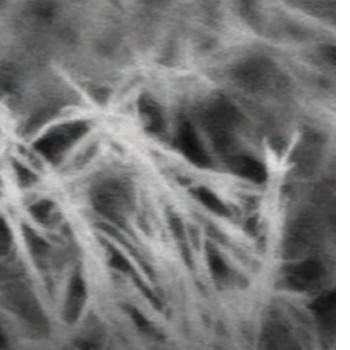 Aerogel presents a visual anomaly, often described as resembling frozen smoke. It permits the passage of light while effectively blocking heat transfer. Notably, Aerogel provides 39 times more insulation than the best fibreglass insulation available. The impact of Aerogel Insulation is remarkable – just a slender 10mm layer enhances the insulation capability of a regular solid wall construction by an impressive 67%.
Aerogel presents a visual anomaly, often described as resembling frozen smoke. It permits the passage of light while effectively blocking heat transfer. Notably, Aerogel provides 39 times more insulation than the best fibreglass insulation available. The impact of Aerogel Insulation is remarkable – just a slender 10mm layer enhances the insulation capability of a regular solid wall construction by an impressive 67%.
Despite its low density, it exhibits incredible strength. Aerogel can withstand compression forces up to 4000 times its own weight. However, despite this notable compressive strength, it is also quite brittle.
One of its most remarkable properties is its thermal insulation capability. This arises from its unique structure, which creates a tortuous and porous path that significantly hinders the conduction of heat, both through the solid material and the gas within its structure.
Although aerogels have been known since the 1930s, it is only in the last 20 years that intriguing applications of this material have emerged.
Pictures credit:youtube.com/watch?v=kHnen2nSmDY
 Aerogel holds potential for use by NASA in spacecraft insulation, and currently, it is employed for residential insulation.
Aerogel holds potential for use by NASA in spacecraft insulation, and currently, it is employed for residential insulation.
With an exceptional thermal conductivity rating of 15mW/mK, aerogel insulation product, finds utility in scenarios where traditional insulations would be impractical due to space constraints. This is particularly crucial in cases where sacrificing space might jeopardise safety or the visual appeal of the project.
Thanks to its hydrophobic nature (offering no transport for liquid), it remains impervious to moisture and the effects of ageing.
This exceptional trait translates to significant, long-lasting energy savings throughout the building's lifespan.
AEROGEL BLANKET
One of the well-known aerogel products is Thermablok Aerogel Insulation Blanket made by Thermablok Aerogels Ltd. Thermablok Aerogel represents a groundbreaking leap in thermal technology. It is is a flexible, nanoporous, breathable, and available in pre-cut slabs/panels measuring 1500mm x 600mm, the insulation comes in various thicknesses, ranging in 10 mm increments from 10mm up to 70mm.

Additionally, rolls with lengths of 10 metres can be provided upon request. It can be applied flexibly wherever other insulations reach their limits. It finds utility in construction for insulating entire wall, floor, and roof sections, as well as addressing localised thermal bridge areas, including timber frames, steel structures, reinforced steel elements, lintels, and window frames.
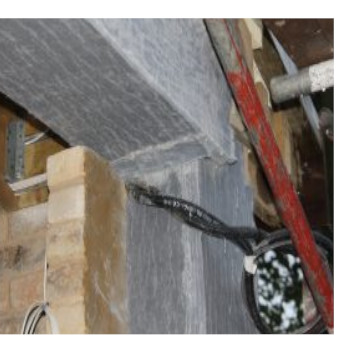
Unlike competitors, Thermablok Aerogel can be mechanically fixed to concrete, brick, wood, and metal, ideal for construction and energy-efficient retrofits.
Thermablok Aerogel Blanket has proudly provided and continues to provide the lowest thermal conductivity among all known insulation materials. This translates to the highest R-value and the lowest U-value, ensuring optimal energy efficiency.
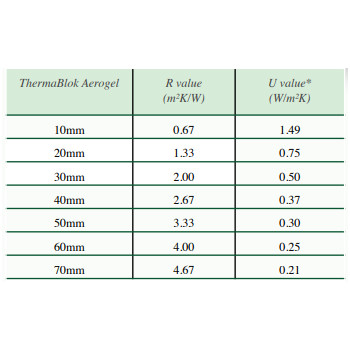
Thermablok Aerogel R-value table
For instance, a 70mm thickness of aerogel provides an R-value of 4.67m2K/W, which is comparable to a 100mm thickness of well-known PIR insulation with a value of 4.50m2K/W. This translates to a 30% reduction in material thickness while achieving the same level of insulation.
What makes this product particularly innovative is its adaptability. The Thermablok Aerogel Blanket can be customised into a specially engineered, user-friendly peel-and-stick strip system. This system effectively addresses localised thermal bridging in both steel and wood substrates, simultaneously boosting assembly R-value ratings.
Company also manufacture Thermablok Aerogel Insulation Blanket into a rigid internal wall insulation board called ThermaSlim IWI (Wall / Reveal) for ease of application.
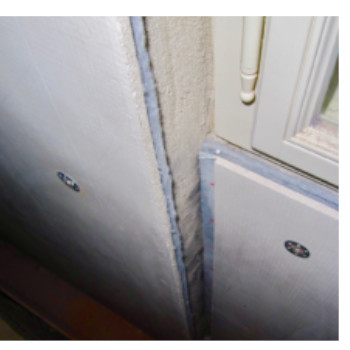
Pictures credit:thermablok.co.uk
Products
• Thermablok Aerogel Insulation Blanket
• Thermablok Aerogel A2 Insulation Blanket
Thermablok Aerogel ThermaSlim Internal Wall /
Reveal / Return Insulation Board Systems (IWI)
• Thermablok Aerogel ThermaSlim Reveal / Return
Insulation Board System
• Thermablok Aerogel ThermaSlim Impact Panel
Internal Floor Insulation (IFI)
• Thermablok Aerogel ThermaSlim External
Insulation Finishing System (EIFS)
• Thermablok Aerogel Strips (Standard & Custom)
② SPRAY FOAM TECHNOLOGY
 Spray foam employs airless spraying to insulate various objects, including homes, industrial structures, and agricultural facilities. This insulation substance is composed of two components blended within the spray gun's nozzle. When combined, these components react, swiftly expanding and solidifying to form a seamless, consistent surface. Unlike conventional insulation materials, polyurethane foam is environmentally benign, allergy-resistant, and unresponsive to the development of mould and fungi.
Spray foam employs airless spraying to insulate various objects, including homes, industrial structures, and agricultural facilities. This insulation substance is composed of two components blended within the spray gun's nozzle. When combined, these components react, swiftly expanding and solidifying to form a seamless, consistent surface. Unlike conventional insulation materials, polyurethane foam is environmentally benign, allergy-resistant, and unresponsive to the development of mould and fungi.
Spray foam, a modern method of home insulation, is invaluable when it comes to soundproofing our roofs. Spray foam insulation can reduce roof noise by up to 60dB, which is significant considering that noise levels comparable to human singing.
Moreover, spray foam offers remarkable airtightness and insulation continuity. No other insulation ensures such seamless coverage. There's no talk of thermal bridging or drafts. The structure of spray foam maintains a unified whole, and any excess is trimmed away.
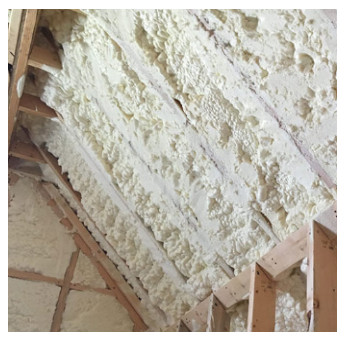
Spray foam is the ultimate solution for hard-to-reach areas. There's likely no better insulation that can so precisely fill even the tiniest crevice. This is due to the expansive properties of this type of insulation. As it dries, its volume increases by at least 10 times, and the force generated during expansion fills every minuscule gap.
Due to its exceptional thermal properties, spray foam can be applied in areas with limited space for insulation, as well as in particularly hard-to-reach places. There are situations where using insulation thicker than 50mm is simply not feasible. In the case of spray foam, its thickness is set right at the beginning using a nozzle on the spray gun.
It's important to emphasise that perhaps the most significant drawback of this innovative insulation is the necessity of hiring a professional company with the appropriate equipment. While this generates additional costs, you can be assured that the work will be done professionally. Spray foam insulation is definitely not recommended for DIY projects.
Unfortunately, in the UK, more and more banks are refusing to provide mortgages for properties where spray foam insulation has been used. This is closely related to the inability to inspect the condition of the roof. If you want to learn more, click here.
③ INSULATED CONCRETE FORMS TECHNOLOGY | STYROFOAM BLOCKS
 The technology of using styrofoam-filled concrete blocks is known as "lost formwork" technology. The formwork is called "lost" because when the styrofoam blocks are filled with concrete, they cease to serve solely as the form for the concrete; they become an integral part of the building's insulation. Remarkably, this insulation happens simultaneously from two sides – both from the exterior and the interior.
The technology of using styrofoam-filled concrete blocks is known as "lost formwork" technology. The formwork is called "lost" because when the styrofoam blocks are filled with concrete, they cease to serve solely as the form for the concrete; they become an integral part of the building's insulation. Remarkably, this insulation happens simultaneously from two sides – both from the exterior and the interior.
Thanks to simultaneous insulation from both the exterior and interior, such walls can achieve an exceptionally low thermal transmittance, characteristic of passive buildings, even as low as U<0.10 W/m²K. Implementing this technology ensures insulation continuity and tightness, even in critical areas like lintels. Through the use of interlocking elements and a monolithic reinforced concrete structure, thermal bridges are entirely eliminated, and there's no risk of plaster shrinkage, both inside and outside the building (no cracks).
With internal styrofoam insulation, the energy expenditure for heating the interior space is minimal, as we are only heating the air. We experience thermal comfort within minutes and can easily control the temperature. Such effective insulation, combined with proper foundation and roof insulation, energy-efficient windows and doors can lead to savings of up to 50% compared to traditionally constructed masonry houses.
In essence, within this system, the concrete creates the structural framework while the styrofoam initially acting as the formwork transforms into a thermal insulation layer after the concrete has solidified. For the exterior, mineral or thin coat renders are commonly applied using a mesh undercoat with adhesive.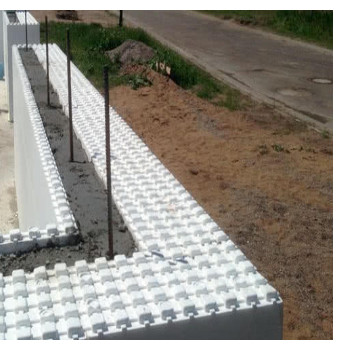
Alternatively, it's possible to use brick slips or wooden siding, as well as Composite Batten Cladding, for the façade. Interior walls can be finished with gypsum plasterboard panels, multi finish plaster, or ceramic tiles.
Building structures using this method is gaining popularity due to its cost-effectiveness compared to other techniques, minimal labour input during construction, and fast construction. Equally significant is the notably low heating costs associated with such buildings compared to traditional methods, for instance. An interesting aspect of this technology lies in the unique distribution of material and labour costs. Here, the material cost is higher, while the construction expenses are lower – a reversal compared to other techniques.
For construction, very lightweight rectangular styrofoam blocks measuring from 1 to 2 metres in length are utilised. These blocks come in various shapes and are hollow in the centre, creating a box-like form without a bottom. This box serves as the formwork into which concrete is poured. It's precisely the unique shape of these blocks and their interlocking design that enables such rapid construction. Similar to building a wall with bricks or blocks, the blocks are stacked on top of each other in an alternating pattern, referred to as a "running bond," but without mortar. This is achievable thanks to special notches and openings along the edges. The wall is erected in stages, laying blocks in increments of 60-70 cm up to 3 metres in height at a time. This considerably shortens the building process. Subsequently, reinforcement is placed within the blocks, followed by pouring concrete. This process is repeated until the wall reaches its full height.
CONCLUSION
In conclusion, the world of insulation is undergoing a remarkable transformation, driven by innovations such as spray foam, aerogel blankets, and Styrofoam EPS blocks. Spray foam stands as a versatile and efficient solution, effectively sealing gaps and ensuring remarkable thermal performance. Aerogel blankets, with their exceptional thermal conductivity and flexibility, mark a new era in insulation technology, offering lightweight and highly efficient solutions. Meanwhile, Styrofoam EPS blocks revolutionise construction, offering both speed and efficiency with their interlocking design and thermal insulation capabilities.
These innovations not only elevate energy efficiency but also redefine how we think about insulation. The development of these advanced materials brings us closer to achieving sustainable, comfortable living spaces while significantly reducing energy consumption. As these technologies continue to evolve, their impact on various industries, from construction to energy conservation, promises a greener and more efficient future for all.
Related articles:
SPRAY FOAM INSULATION - IS IT REALLY THAT GOOD?
THE PRICE OF COMFORT: UNRAVELLING WHY INSULATION IS SO EXPENSIVE
WHAT TO CONSIDER WHEN CHOOSING INSULATION MATERIALS
MASTERING HOME INSULATION: UNLOCKING COMFORT, ENERGY EFFICIENCY, AND SAVINGS
*All the information provided in the content published on Insulationgo blog is for informational and educational purposes only. Insulationgo LTD makes every effort to ensure the accuracy and timeliness of the content, but we do not assume any responsibility for any errors or omissions.
The information presented on this blog should not be considered as professional advice or a substitute for consulting relevant experts. Before making any purchase decisions or taking action based on the information presented here, it is strongly recommended to contact the product manufacturer directly to verify the details and ensure its suitability for your specific needs.
Any descriptions, drawings, photographs, data, proportions, weights, measured values etc. given herein may change without prior notice and do not constitute the agreed contractual quality of the products. It is the responsibility of the recipient of all products to ensure that any proprietary rights and existing laws and legislation are observed.
By using this blog, you acknowledge and agree that Insulationgo LTD shall not be held liable for any damages, losses, or inconveniences arising from the use or reliance on the information provided herein. This limitation of liability applies to all users of the blog, including but not limited to visitors, readers, and subscribers.
Pictures credit:
thermablok.co.uk,purios.com,pak.info.pl,brokerbudowydomow.pl,geekweek.com










































































































